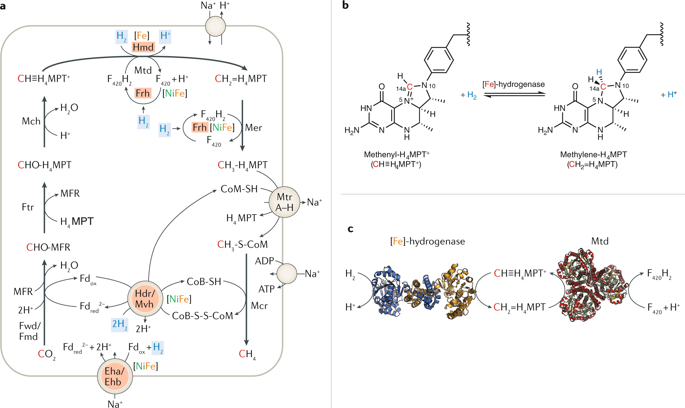Nature Reviews Chemistry ( IF 36.3 ) Pub Date : 2020-02-20 , DOI: 10.1038/s41570-020-0167-2 Gangfeng Huang 1 , Tristan Wagner 2 , Ulrich Ermler 3 , Seigo Shima 1

|
Certain anaerobic microorganisms evolved a mechanism to use H2 as a reductant in their energy metabolisms. For these purposes, the microorganisms developed H2-activating enzymes, which are aspirational catalysts in a sustainable hydrogen economy. In the case of the hydrogenotrophic pathway performed by methanogenic archaea, 8e− are extracted from 4H2 and used as reducing equivalents to convert CO2 into CH4. Under standard cultivation conditions, these archaea express [NiFe]-hydrogenases, which are Ni-dependent and Fe-dependent enzymes and heterolytically cleave H2 into 2H+ and 2e−, the latter being supplied into the central metabolism. Under Ni-limiting conditions, F420-reducing [NiFe]-hydrogenases are downregulated and their functions are predominantly taken over by an upregulated [Fe]-hydrogenase. Unique in biology, this Fe-dependent hydrogenase cleaves H2 and directly transfers H− to an imidazolium-containing substrate. [Fe]-hydrogenase activates H2 at an Fe cofactor ligated by two CO molecules, an acyl group, a pyridinol N atom and a cysteine thiolate as the central constituent. This Fe centre has inspired chemists to not only design synthetic mimics to catalytically cleave H2 in solution but also for incorporation into apo-[Fe]-hydrogenase to give semi-synthetic proteins. This Perspective describes the enzymes involved in hydrogenotrophic methanogenesis, with a focus on those performing the reduction steps. Of these, we describe [Fe]-hydrogenases in detail and cover recent progress in their synthetic modelling.
中文翻译:

产甲烷涉及从 H 2 到有机底物的直接氢化物转移
某些厌氧微生物进化出一种机制,在它们的能量代谢中使用 H 2作为还原剂。出于这些目的,微生物开发了 H 2激活酶,它们是可持续氢经济中的理想催化剂。在产甲烷古菌执行的氢营养途径的情况下,8e -从4H 2中提取并用作还原当量以将CO 2转化为CH 4。在标准培养条件下,这些古细菌表达 [NiFe]-氢化酶,它们是 Ni 依赖性和 Fe 依赖性酶,并且将 H 2异裂解为 2H +和 2e -,后者被供应到中央代谢。在 Ni 限制条件下,F 420还原 [NiFe]-氢化酶被下调,它们的功能主要由上调的 [Fe]-氢化酶接管。这种 Fe 依赖性氢化酶在生物学上是独一无二的,它可以裂解 H 2并将 H -直接转移到含咪唑底物上。[Fe]-氢化酶在由两个 CO 分子、一个酰基、一个吡啶醇 N 原子和作为中心成分的半胱氨酸硫醇盐连接的 Fe 辅助因子处激活 H 2 。这个 Fe 中心启发了化学家不仅设计合成模拟物来催化裂解 H 2在溶液中也可掺入 apo-[Fe]-氢化酶以产生半合成蛋白质。该观点描述了参与氢营养型甲烷生成的酶,重点是那些执行还原步骤的酶。其中,我们详细描述了 [Fe]-氢化酶,并介绍了它们合成模型的最新进展。



























 京公网安备 11010802027423号
京公网安备 11010802027423号